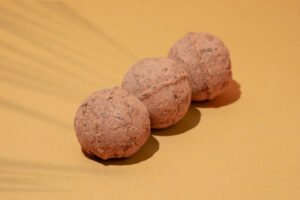Seed Bombs in a Box
Request a Quote
Features:
Components
Seed Bombs
Dimensions
Ø3.3 cm
Ø2.5 cm
Printing Inks
Minimum Quantity
Options
Different colors of bombs available.
More information:
What are seed bombs?
Seed bombs are small balls made from a mix of clay, compost, and seeds. They are designed to be tossed onto the ground where they can grow without needing to be planted directly. When conditions are right, the seeds within the bomb sprout, creating plants in areas where traditional planting may not be possible. Seedpaper’s seed bombs are an eco-friendly option for promoting biodiversity and greening spaces.
How to plant seed bombs?
To plant seed bombs, simply toss or place them on soil in a sunny area. Ensure the area receives adequate rainfall or water them regularly to support germination. Over time, the outer layer will break down, allowing the seeds to sprout. Seed bombs are ideal for adding greenery to hard-to-reach areas or for guerrilla gardening in public spaces.
When to plant seed bombs in the UK?
In the UK, the best time to plant seed bombs is in the spring or early autumn when there is plenty of rain to support germination. Planting in these seasons gives the seeds the best chance to establish and grow before winter or the dry summer months. Avoid planting during frost or dry periods, as seeds need warmth and moisture to thrive.
Are seed bombs effective?
Yes, seed bombs can be effective when used in appropriate conditions. They are particularly useful for planting in areas that are difficult to cultivate by traditional methods. Seed bombs require moisture, sunlight, and a suitable location to be effective, and when these needs are met, they can grow into healthy plants that support local ecosystems.
Do seed bombs work?
Yes, seed bombs work well in environments where there is sufficient moisture, sunlight, and nutrient-rich soil. They are designed to simplify the planting process, making it easier to introduce plants to areas where digging is impractical. Seedpaper seed bombs use high-quality seeds suited to local conditions, enhancing their effectiveness and contribution to biodiversity.

